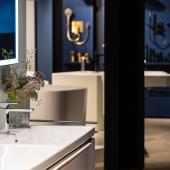The classical style: at the origins of beauty
Pamela Albanese - TosiLab
The current re-emergence of the classical style suggests that the vision of Johann Joachim Winckelmann, that invites to consider the underlying reasons why ancient works were made so as to be able to transfer them to new creations, has been taken on board by aesthetic disciplines at an international level. During the various design weeks held in Milan, Northern Europe and the United States, our trendwatchers noted strong interest in this style in a range of fields, from accessories to interior design.
A symptom of this is the growing passion for natural materials that evoke the glories of antiquity.
Perhaps the most obvious example is the popularity of Carrara marble in all its versions. Used on floors, walls and furniture, its fluid vein pattern has proved ideal for transposition to soft surfaces such as bedlinen, T-shirts and covers for notebooks and electronic devices.
Modern-day applications of classical styles take many different forms. The most frequent way of evoking the origins of beauty is to transfer today’s products to contexts with a classical flavour. This, for example, was the approach adopted by Lago for one of the installations in Never Stop Designing Spaces. In this setting reminiscent of Palladian villas, the frescoes with trompe l’oeil human figures served as the perfect backdrop to the company’s new products. This technique also works well in the visually-striking Edra stand, which uses giant LED walls to project images of sculptural classicism.
Other references – including decorations and structural elements such as columns and wall panelling – are ubiquitous in the field of design advertising. Baxter, Meridiani, Maxalto, Trussardi Casa and Derucci Milano adopt this approach in a composed manner, setting their products against the backdrop of classical scenes. A bolder approach has been taken by Poltrona Frau, which embraces the principle of symmetry by setting its chairs against visually-striking artistic backgrounds.
Another common approach is to achieve optical effects through a contrast between black and white, as in the case of Zanotta and Doimo Cucine.
Some brands are exploring the pure Arcadian principles of rationalisation of forms, structural clarity and correspondence between parts, and presenting furnishings and concepts that are Hellenic in origin. There are ancestral psychological reasons why the criteria that define this style satisfy the needs of today’s society. In comparing classical and baroque aesthetics, semiologist Heinrich Wölfflin argued that the representations of classicism are discontinuous, linear and insulating while expressing much more serene content inherent to a universe that can be grasped with the intellect. In short, our minds appreciate a sense of balance. We should also not forget that contemporary society is constantly in search of the concept of “good living”.
The Amsterdam-based Italian design duo Formafantasma, renowned for their subversive way of blending the canons of classicism, recently created a collection inspired by the ruins of Rome, for example choosing travertine for a lamp that recalls the oculus of the Pantheon. Lapo Ciatti, on the other hand, has revisited the tradition with a sense of irony and sophistication, designing a line of wing chairs and poufs named Guelfo as a tribute to the faction that contributed so much to Florentine culture.
Returning to the Milan Furniture Fair, an 800-square-metre exhibit in the Rho exhibition centre entitled Before Design: Classic represents a novel idea of “classic” as a gaze back at the past, a barometer for the present and a springboard towards the future. The argument is that classicism arrived before true design, and key figures like Andrea Palladio played a pioneering role in creating models that transcend the meaning of individual works. The focus of the exhibit is a home with a sequence of rooms containing multimedia and sensorial installations that epitomise modernity. The centrepiece is a short film by Matteo Garrone that interprets the ancestral concept of beauty and strives to overcome cultural and time barriers. Against the backdrop of a dreamlike, post-atomic landscape, only children are able to maintain a pure gaze onto beauty. They restore, clean and preserve for posterity the items of furniture that stand out against the background with their shapes and colours and become the key players in the video. The companies that have supplied installation products have paid tribute to traditional Italian taste, a timeless category that touches on all aspects of living.
This event-within-an-event is particularly in keeping with the sentiment expressed by art historian Salvatore Settis in 2004 when he published his work The future of the classical. Ancient concepts can still be deployed with vitality provided we consider them to be a meeting point between cultures, a laboratory for hybridisation and mutuality, he argued. The classical is not an immutable entity, but a point of convergence between identity and otherness. It crucial for us to study it as we recognise it as belonging to us while being different from us. It is part and parcel of western culture, a compass and a mirror in which we can recognise our own values. But at the same time its inexorable foreignness helps us understand other cultures.
Did you find this article useful?
Join the CWW community to receive the most important news from the global ceramic industry every two weeks





















